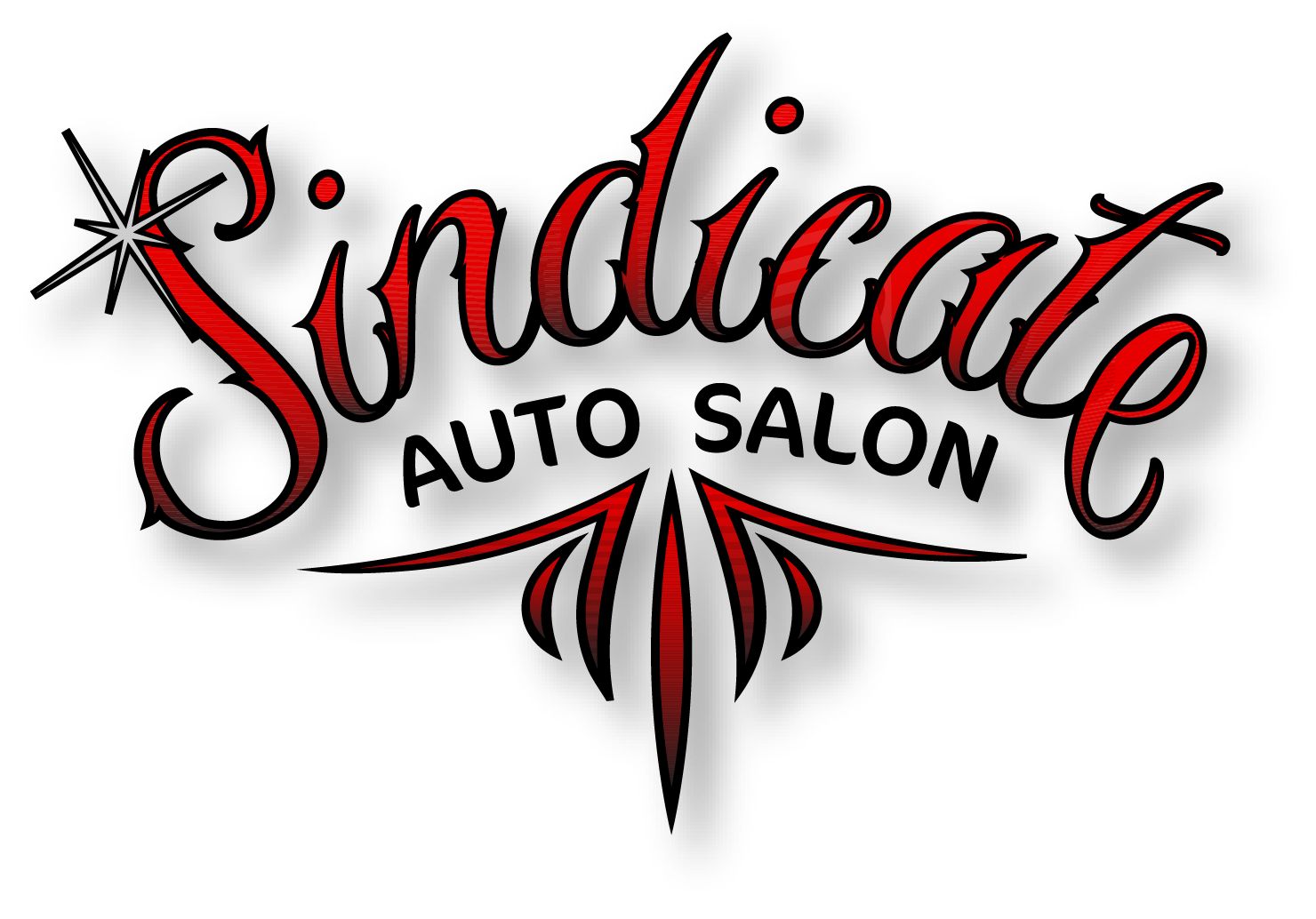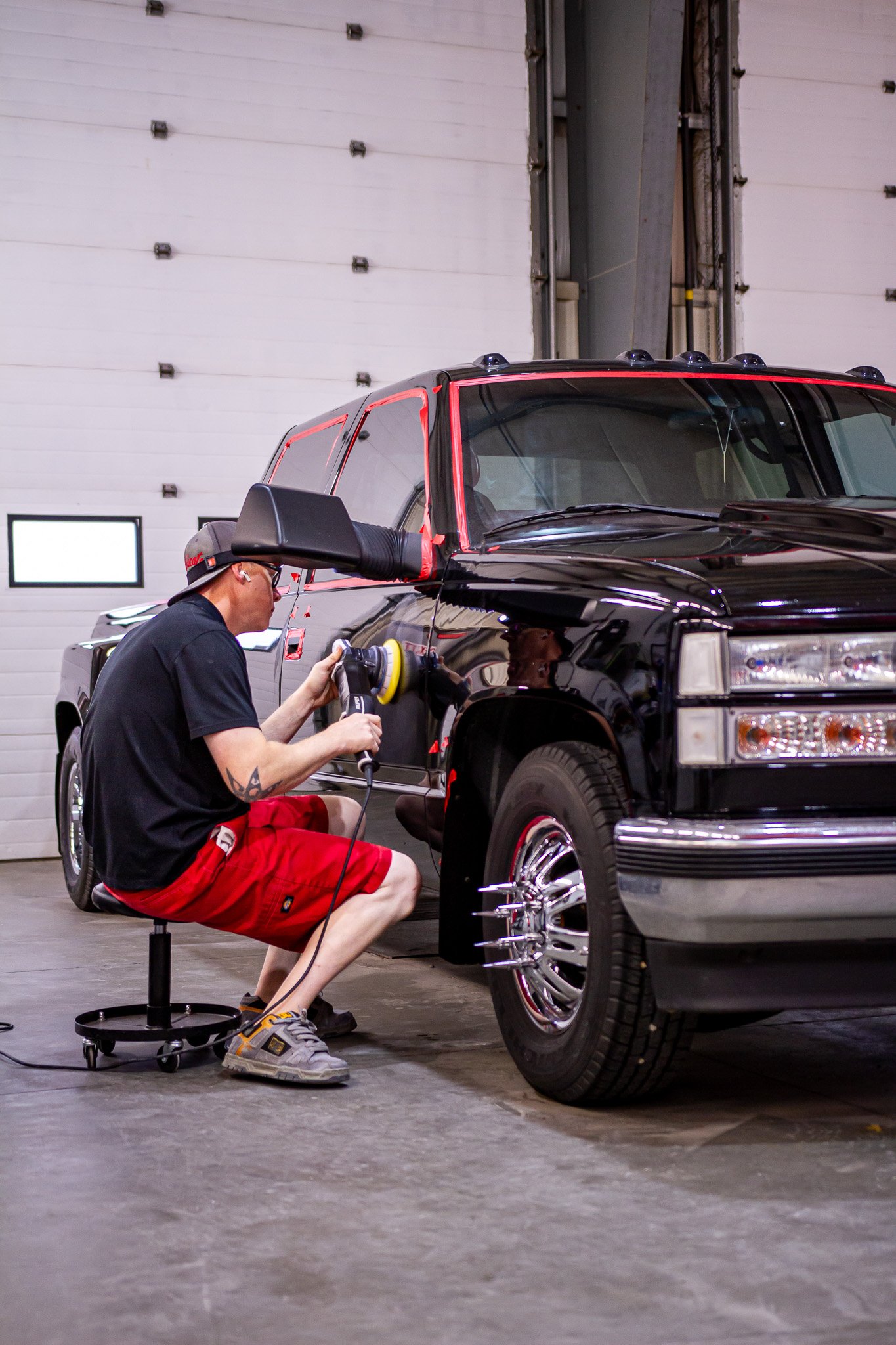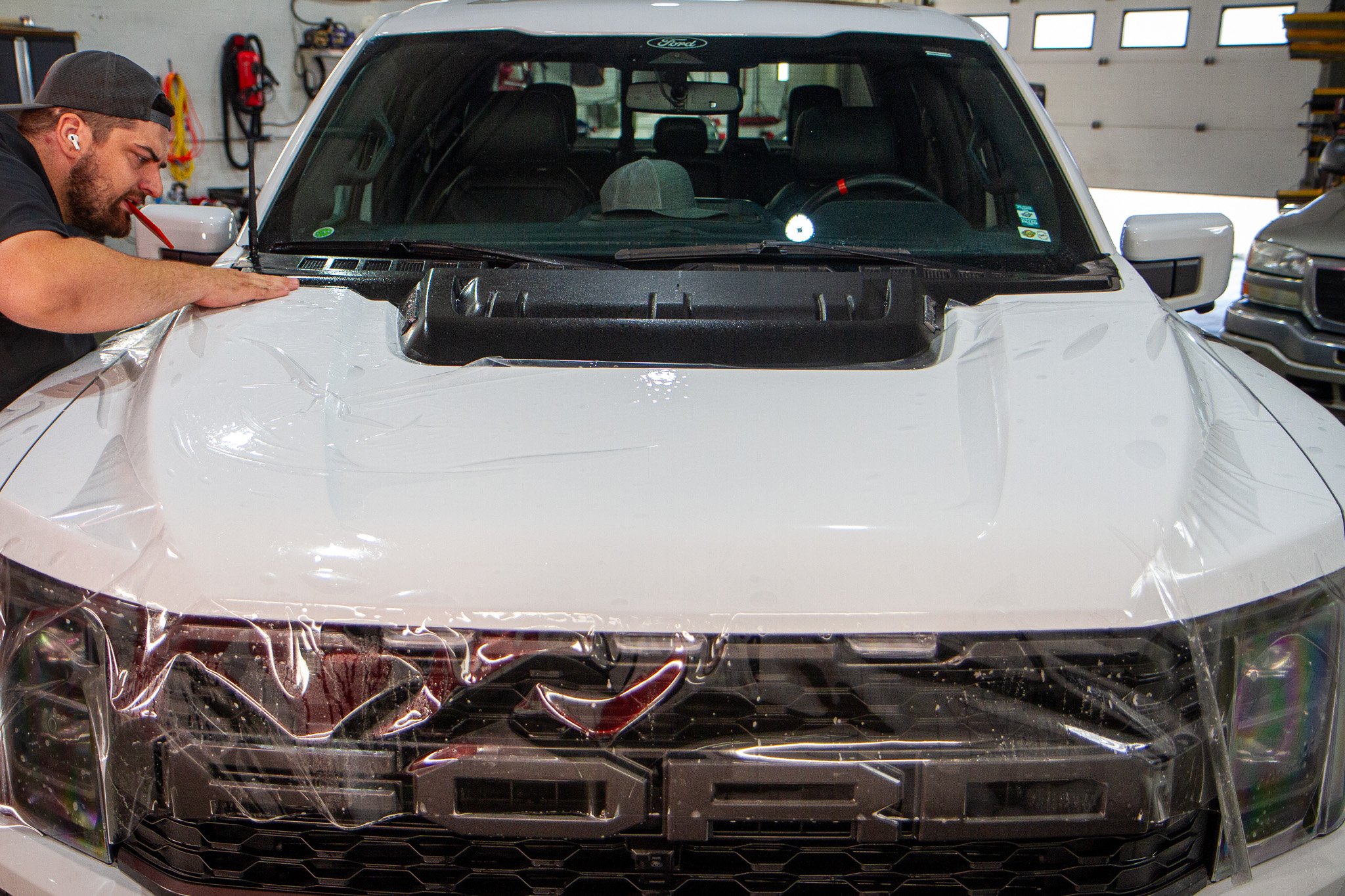PPF vs. Ceramic Coating - Which is Better Protection for Your Vehicle?
Do you want to protect your vehicle, but you’re not sure what option is best? Paint protection film (PPF) and Ceramic coatings both act as a sacrificial layer to your vehicle’s paint, but they offer two different types of protection.
We’re going to compare their protection, go over the best uses, and (spoiler alert) explain why we’ll usually recommend combining both for ultimate protection. Especially with new vehicle paint being thinner than ever.
Installing SunTek Paint Protection Film
The What and How.
PPF: This is a tough, near invisible film and is specifically designed to take impact and protect from rock chips, road debris, scuffs and scratches. PPF is also the only solution for protecting your vehicle's paint from physical damage while still preserving the paint underneath (opposed to rock guard, like Line-X, Raptor Liner, Body Liner). It can be applied to new or used vehicles and is meant for smooth, painted surfaces. It is also self healing, which means with heat, it can “heal” micro scratches.
Quick PPF myths to debunk: it will not self heal rock chips or large gouges and it isn’t bullet proof (but, it can take significant impact).
SB3 Ceramic Coating being applied to an applicator.
CERAMIC COATINGS: A ceramic coating is a liquid polymer protective product that has similar benefits to traditional car wax, but it’s longer lasting since they’re more durable. They interlock and chemically bond with the surface to create a hydrophobic layer to offer long term chemical and contamination protection from UV rays, bird droppings, water spots, oxidation and more. The hydrophobic surface is slick, so removing dirt or bugs will be much easier.
Quick coating myths to debunk: they won’t help with impact protection, they aren’t scratch proof to any significant extent, they don’t fix clear coat issues, and they are not “set it and forget it”.
Best Uses.
PPF: Clear PPF is commonly applied to high impact areas, including but not limited to: the hood, fenders, bumpers, rockers, headlights, roof strip, a-pillars, door cups, door sills, rear bumper, etc.. You can also PPF an entire vehicle, however it’s less common, and in most cases unnecessary. Mostly due to a significant jump in price to do so, but also because protecting the your vehicle’s high impact areas is usually adequate.
PPF needs a smooth, clean surface to properly adhere and look its best. Paint that has a lot of rock chips isn’t ideal for PPF, since it won’t properly adhere to the uneven texture. This is why it’s important to protect the new (or freshly painted surface) ASAP. Since PPF needs a smooth surface, certain textured areas cannot be protected either, such as textured rockers on some newer trucks.
SunTek PPF Installed on the partial hood, partial fenders, front bumper, mirrors and door cups.
CERAMIC COATINGS: Basically wax on steroids! Ceramic coatings are commonly enjoyed for their ability to make washing easy and adding additional gloss to the vehicle, without frequent reapplication needed like traditional wax.
But most importantly, they protect from chemicals or contaminants. They can also be applied to other exterior areas like the trim to prevent fading, the wheels to aid with cleaning or the glass to encourage less use of wipers.
Fun fact: there are also coatings available to help you protect your interior surfaces, like leather or fabric coatings.
Appearance.
PPF: Quality PPF should be optically clear and have minimal "orange peel” effect to the finish.. Edges can be noticeable (such as across hoods, or any relief cuts needed for high tension areas or harsh angles), mostly due to the ledge allowing dust/dirt to rest up against it. It will not hide imperfections like rock chips, but it can actually make light swirling less noticeable.
There are other options like black or coloured PPF, or even matte PPF, which can all be used for both protection and to change appearance, whether that’s just on specific areas or the whole vehicle.
SunTek PPF was installed on the full hood, full fenders, doors and box sides. Full coverage was important as this truck was recently repainted, and our customer wanted to reduce any visible seams.
CERAMIC COATINGS: Ceramic Coatings enhance depth of the paint, so, if professionally installed, it will have a glossy, slick finish. It will not change the colour of the paint. Overall, aside from the additional gloss, you won’t be able to “see” the coating. However, if the vehicle is wet, you should notice the hydrophobic properties in action with water beading or sheeting on top of the coated surface.
Longevity & Upkeep.
PPF: Depending on the brand and with proper care, PPF is designed to last anywhere from 5-10 years. The most basic care for it would be to keep the vehicle clean, and removing contaminants. Quality films are designed to resist breakdown of the finish, but spray wax, sealants or ceramic coatings can help further protect the finish and prolong longevity.
Over it’s lifespan, the film will likely take some abuse and even quality films will eventually become outdated and require replacement. Keeping PPF on for a lot longer than its suggested lifespan can become more harmful than helpful, and removing outdated film can be very labour extensive since the adhesive will start to deteriorate. If you’re coming to the end of the films stated warranty (5-10 years), consult with a reputable shop to see if and when you should be looking to replace it.
CERAMIC COATINGS: Available in different durations, ceramic coatings are typically offered anywhere from 1- 7 years, assuming basic upkeep has been done. This means regular washes (every 1-2 weeks) and semi-regular "decontamination washes” (1-2 times a year, at minimum).
Doing both of these will help keep the coating performing as it should, and can even extend the life. Decontamination washes are important because, like paint, ceramic coatings have pores that can get clogged over time from road grime, mud, etc.. This can make it seem like the coating has “failed” or stopped working, but the surface just needs to be stripped of contaminants. If neglected for too long, it can degrade your coating much quicker, which is why it’s important to make sure it’s done as regularly as needed. If you drive harsh conditioners frequently, 2 times a year might not be enough.
At Sindicate Auto Salon, we include routine decontamination washes (twice a year) as part of the ceramic coating package. We do it ourselves to make sure it’s been done both correctly and regularly, as this is a crucial part of maintaining a ceramic coating throughout its stated lifespan.
To remove a professional ceramic coating, they need to be polished off. If you’ve reached the end of the stated lifespan and you don’t want to reapply, there won’t be any harm to the vehicle if left. It will just simply degrade and wear off over time.
Cost.
PPF: If you were to PPF an entire vehicle, it would be a lot more costly than ceramic coating a whole vehicle. But as we mentioned above, most people don’t need paint protection film on the entire vehicle and instead will get high impact zones protected, bringing down the cost quite a bit. The reliability that comes with purchasing quality film that is professionally installed may cost a little more, but should be considered as an investment.
Also, it’s worth considering that if damage were to happen to film on any of these areas, replacing that piece or section will less expensive than having to repaint the panel.
CERAMIC COATINGS: It’s common for ceramic coatings to vary in price, depending on the product and process involved. To perform the best, the coating must properly bond to the surface. The process of applying the coating itself is not technical, but preparing the surface properly for ceramic coatings is where it’s more precise. Typically, a proper ceramic coating application should include an initial decontamination and (at least) a single stage polish. This also helps boost gloss, but also important to ensure a proper bond of the ceramic coating to the paint. The prep (or lack thereof) could cause a large variance in price, so it’s important to see what is included with your ceramic coating installation.
At Sincidate Auto Salon, our price also includes routine maintenance washes - a crucial part of the upkeep process, as mentioned above.
For Both Products…
When choosing either (or both) a PPF or Ceramic Coating product, it's important to research the shop, make sure the installer has proper experience and skills and to ask about the brand, product quality and warranty. If you have a quality product but a poor install, it could look unsightly or cause issues later on.
Also, you should factor in that products that simply anyone can purchase, like Gila, Chemical Guys, Revivify, or Canadian Tire tint or coatings, are undeniably lower in quality. This results in products that are either not meant to last and/or will be less durable or effective. Products that are designed for professional use are usually more complex to install and will give you a more reliable product.
Also, be cautious when navigating these options through dealerships, as they’re notorious for selling low quality products and/or install at a premium price. In fact, we have a whole separate blog post on that here.
Should You Combine PPF & Ceramic Coatings?
PPF and Ceramic Coatings offer different types of protection - but you don’t have to choose just one. In fact, the majority of time we recommend combining both for ultimate protection.
Ceramic coatings can be applied over PPF, but they must be installed last for the film to stick to the surface due to the hydrophobic properties of coatings. The coating will also make maintaining the PPF easier, thanks to its hydrophobic surface. It will also provide uniform UV protection and add gloss to the entire vehicle for a slick, “wet” look.
With this dynamic duo, you’ll get tough protection with PPF on high-impact zones and an all over chemical shield from everyday contaminants with Ceramic Coatings. And, washing will be a breeze!
The Main Point.
The key to maintaining the value and appearance of your vehicle is preventative maintenance. Knowing the unique benefits of these two types of protection will help you decide which option is right for your vehicle.
Making sure you are researching the shop and the brands they use is also important in making sure you’re getting a quality product that you’ll be happy with for years to come.
Lastly, following aftercare instructions and making upkeep a priority for both will help maintain appearance, longevity and effectiveness of these products.
If you have questions, feel free to contact us or a local detail shop in your area.













